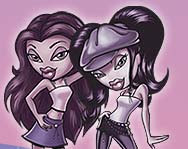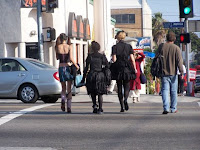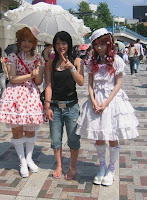 Harajuku girls, used to identify girls who gather in Harajuku district, Tokyo, Japan. Their costumes is in several different styles of clothing that originated in the culture of Japan's major cities.
Harajuku girls, used to identify girls who gather in Harajuku district, Tokyo, Japan. Their costumes is in several different styles of clothing that originated in the culture of Japan's major cities.The term is not only monopolized by those who gather in the district themselves, but has become a relatively popular expression in the United States. Popular use originated from the American singer Gwen Stefani's 2004 Love.Angel.Music.Baby album, which brought attention to Stefani's entourage of four supposed "Harajuku Girls" who were hired to portray the look, three of whom are Japanese and one of whom is Japanese American. These "Harajuku Girls" are not in fact the fashion aficionados or the home sewing hobbyists from whence they derive their name.


 Harajuku is a popular iconic placed in the world of entertainment, inside and outside of Japan. It was said that the girls of Harajuku are “beauty stars of Japan”. The American singer Gwen Stefani puts Harajuku reference in several of her songs and incorporated four female dancers, appointed under the name of “love,” “angel,” “music,” and “baby,” dressed like girls with Americanised Harajuku, as her background act.
Harajuku is a popular iconic placed in the world of entertainment, inside and outside of Japan. It was said that the girls of Harajuku are “beauty stars of Japan”. The American singer Gwen Stefani puts Harajuku reference in several of her songs and incorporated four female dancers, appointed under the name of “love,” “angel,” “music,” and “baby,” dressed like girls with Americanised Harajuku, as her background act.


 A song is devoted to them on the album which she called after them, entitled of the “Harajuku Girls” and the word “??” (Harajuku) is depicted on the surface of stage during her music video for the Hollaback Girl. In her songs, Stefani mispronounces the word Harajuku. Instead of the Japanese pronunciation, Stefani spells “hair-ajuku,” although the Japanese loudspeakers on its album pronounce the word correctly. Her use--which critics call her appropriation--of Harajuku girls and Harajuku fashion was criticized by a certain number of Asian-Americans, in particular Margaret Cho, to perpetuate stereotypes of the flexible Asian women.
A song is devoted to them on the album which she called after them, entitled of the “Harajuku Girls” and the word “??” (Harajuku) is depicted on the surface of stage during her music video for the Hollaback Girl. In her songs, Stefani mispronounces the word Harajuku. Instead of the Japanese pronunciation, Stefani spells “hair-ajuku,” although the Japanese loudspeakers on its album pronounce the word correctly. Her use--which critics call her appropriation--of Harajuku girls and Harajuku fashion was criticized by a certain number of Asian-Americans, in particular Margaret Cho, to perpetuate stereotypes of the flexible Asian women.

 According to the Jan/Feb 2006 edition of Blender magazine, American comedian Margaret Cho has labeled Stefani's Harajuku Girls a "minstrel show" that reinforces ethnic stereotypes of Asian women. [1]. The Harajuku Girls have continued to appear alongside Stefani in the media, and are featured in the music video for "Wind It Up" (2006). If you search the term Harajuku girls in internet, most probably you will find Gwen Stefani name also as the search results.
According to the Jan/Feb 2006 edition of Blender magazine, American comedian Margaret Cho has labeled Stefani's Harajuku Girls a "minstrel show" that reinforces ethnic stereotypes of Asian women. [1]. The Harajuku Girls have continued to appear alongside Stefani in the media, and are featured in the music video for "Wind It Up" (2006). If you search the term Harajuku girls in internet, most probably you will find Gwen Stefani name also as the search results.
 Gwen Stefani, singer principal of the pop band No Doubt, has lead Madonna-esque fashion revolt in both her recent video clip for her single What You Awaiting For and her solo album Love, Angel, Music, Baby. Its involving in 80’s inspired popish tunes, platinum blonde hair and Like A Virgin kit outside the art cover of album reinforce her homage to the material girl, though it can be slightly language in the cheek. In 2006, Stefani launched a second clothing line, called the “Harajuku lovers,” she said it is inspired by the zone of Harajuku in Japan. But its her references to the girls of Japanese Harajuku peppered in all the album and on a way in particular which drew the interest from a various range of te commentators. However who are these Harajuku Girls?
Gwen Stefani, singer principal of the pop band No Doubt, has lead Madonna-esque fashion revolt in both her recent video clip for her single What You Awaiting For and her solo album Love, Angel, Music, Baby. Its involving in 80’s inspired popish tunes, platinum blonde hair and Like A Virgin kit outside the art cover of album reinforce her homage to the material girl, though it can be slightly language in the cheek. In 2006, Stefani launched a second clothing line, called the “Harajuku lovers,” she said it is inspired by the zone of Harajuku in Japan. But its her references to the girls of Japanese Harajuku peppered in all the album and on a way in particular which drew the interest from a various range of te commentators. However who are these Harajuku Girls?
 The Harajuku District of Tokyo and in particular street of Takeshita, a narrow street furnished with the stores is the brilliant house for these fashionistas. Since the end of the Second World War, the “consumerism” and “consumption” are becoming national past-time for most Japanese and in particular to teenager girls who often live at the house with their parents well until their twenties. Their free existence of rent provides them enough funds to gather at Harajuku each weekend, where they transform themselves into baby doll of Lolita-esque caracitures. Of course it is an extreme-pretty combination of dressing, but however you will find kind of oase of japanese dress besides their ordinary-working-day dress which is everything is very ordered and conservative.
The Harajuku District of Tokyo and in particular street of Takeshita, a narrow street furnished with the stores is the brilliant house for these fashionistas. Since the end of the Second World War, the “consumerism” and “consumption” are becoming national past-time for most Japanese and in particular to teenager girls who often live at the house with their parents well until their twenties. Their free existence of rent provides them enough funds to gather at Harajuku each weekend, where they transform themselves into baby doll of Lolita-esque caracitures. Of course it is an extreme-pretty combination of dressing, but however you will find kind of oase of japanese dress besides their ordinary-working-day dress which is everything is very ordered and conservative.

 Various fashion styles is available among the girls who spend time in Harajuku, including Gothic Lolita, Gothic Maid, Wamono, Decora, Second-Hand Fashion, and cyber fashion. The Japanese street fashion magazine, FRUiTS, features many of the varied clothing styles that are popular in the Harajuku district. They wear fake blood and bandages, and dark outfits often combined with traditional Japanese clothing (kimonos, fans) and modern Japanese symbols (hello kitties, cell phones, photo stickers). What drives these girls to dress in such outrageous outfits in a weekly ceremony that lasts only a few hours? Is there a really great bordem in Japanese society so this is one of their way to release all of those bordem?
Various fashion styles is available among the girls who spend time in Harajuku, including Gothic Lolita, Gothic Maid, Wamono, Decora, Second-Hand Fashion, and cyber fashion. The Japanese street fashion magazine, FRUiTS, features many of the varied clothing styles that are popular in the Harajuku district. They wear fake blood and bandages, and dark outfits often combined with traditional Japanese clothing (kimonos, fans) and modern Japanese symbols (hello kitties, cell phones, photo stickers). What drives these girls to dress in such outrageous outfits in a weekly ceremony that lasts only a few hours? Is there a really great bordem in Japanese society so this is one of their way to release all of those bordem?

 Some of the answers are more immediately visible. For example, we know some of them are imitating rock bands such as Japan X. However, as with all cultural symbols, there are likely to be deeper reasons beyond fashion. The weekly play allows them to temporarily escape, within a group, all of the rules of Japanese society. It gives them individuality not as easily expressible while in their weekday school uniforms, it gives them a voice to express, often in very sexual ways (with ripped stockings, garters, and mini-skirts, etc.), the oppression of the female gender in the largely male dominated Japanese society.
Some of the answers are more immediately visible. For example, we know some of them are imitating rock bands such as Japan X. However, as with all cultural symbols, there are likely to be deeper reasons beyond fashion. The weekly play allows them to temporarily escape, within a group, all of the rules of Japanese society. It gives them individuality not as easily expressible while in their weekday school uniforms, it gives them a voice to express, often in very sexual ways (with ripped stockings, garters, and mini-skirts, etc.), the oppression of the female gender in the largely male dominated Japanese society.
 It is whole kind of a pop-art meets pop-culture meets decadence kinda street where oWesternften a t-shirt with a western image like Mickey Mouse can go for several hundreds of dollars a noise. This constant continuation of rock n roll pop star hipness is prolonged with the boys of teenager too. They turn to choose western inspired hip-hop culture of disheveled jeans hanging halfway to their knees, of the hats to all the angles on their heads and surely many, many, many of blings.
It is whole kind of a pop-art meets pop-culture meets decadence kinda street where oWesternften a t-shirt with a western image like Mickey Mouse can go for several hundreds of dollars a noise. This constant continuation of rock n roll pop star hipness is prolonged with the boys of teenager too. They turn to choose western inspired hip-hop culture of disheveled jeans hanging halfway to their knees, of the hats to all the angles on their heads and surely many, many, many of blings.
 So often, the net result resembles something out of a comic book of Manga while the fashionistas of Harajuku compete to look less human and more iconic. Not pay attention to what we in the west may see like a conflict of fashion above substance, girls of Harajuku is different to Goths, punks and bond girls which became trends previously, is not about rebellion to the society. It is just a crazy-extreme-freedom expression of dressing in certain day (sunday), free from those ordinary dress which requires them to dress "politely, nice, and good looking".
So often, the net result resembles something out of a comic book of Manga while the fashionistas of Harajuku compete to look less human and more iconic. Not pay attention to what we in the west may see like a conflict of fashion above substance, girls of Harajuku is different to Goths, punks and bond girls which became trends previously, is not about rebellion to the society. It is just a crazy-extreme-freedom expression of dressing in certain day (sunday), free from those ordinary dress which requires them to dress "politely, nice, and good looking".

 Harajuku Girls just like most Japanese, are often extremely polite and happy to pose for photographs with the curious tourists who flock each Sunday to take the happy snap of these caricatures of super-model. Just ask them for a photograph nicely, they will do that happilly. And as a gratitude you can offer them something, ussualy they won't ask something out of your reach. For the girls of Harajuku, their most extreme request can be a simple cigarette.
Harajuku Girls just like most Japanese, are often extremely polite and happy to pose for photographs with the curious tourists who flock each Sunday to take the happy snap of these caricatures of super-model. Just ask them for a photograph nicely, they will do that happilly. And as a gratitude you can offer them something, ussualy they won't ask something out of your reach. For the girls of Harajuku, their most extreme request can be a simple cigarette.Information about Harajuku.
No comments:
Post a Comment